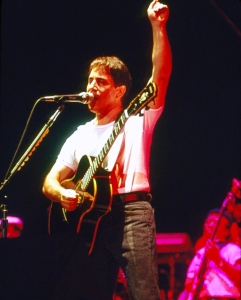“Nearly forty years ago, Paul Simon built a bridge with Graceland, introducing Western ears to South African rhythm”
By Clayton “Tiger” Hulin, photo of Paul Simon by Raj Rama
Back in 1986, Paul Simon hauled a bag of microphones and curiosity to South Africa and cut Graceland. He borrowed township rhythms, guitar licks that danced like sunlight, and voices that carried a weight older than America itself. For a generation of American listeners, it was their first taste of African sound, filtered through a familiar Western storyteller.
Fast-forward to today, and you can still hear faint shades of Graceland in the shuffle of a new sound rising out of Johannesburg townships: Amapiano. It is deep house with a log-drum bass that seems to rise from the floorboards and climb right into your chest. It is hypnotic, patient, trance-like. It doesn’t shout for attention, it seduces it. And unlike in Simon’s day, nobody needs a Western passport to carry it across the ocean. Africa is exporting itself now, and the world is dancing to its beat.
The same is true in the Latin world. Reggaeton, once dismissed as too raw, is now the oxygen of pop charts. Bad Bunny packs stadiums bigger than rock bands ever dreamed of. Karol G and J Balvin are household names. And then there’s Afrobeats, rolling out of Nigeria with breezy grooves that sound like summer bottled. Burna Boy headlines Glastonbury, Tems sings hooks for Drake and Beyoncé, and suddenly the map of pop music looks upside down.
For the first time in living memory, pop music’s pulse isn’t dictated by New York or London. The center has shifted south. Lagos, Johannesburg, and San Juan set the tempo now, and the rest of the world scrambles to keep up.
The History in the Beat
Every rhythm has a story. And the story of today’s global sound begins in the shadows of history.
Reggaeton rides on the dembow rhythm, a pattern that traces back to Jamaican dancehall and Panamanian reggae en español. But if you keep digging, you find its roots in the African drum traditions carried across the Atlantic in chains. What was once a heartbeat on a ship’s hold has become the pulse of stadiums worldwide.
Afrobeats is not just a trend, it’s the continuation of highlife, Afrobeat, gospel, and hip-hop fused together by Nigeria’s new generation. Burna Boy, Wizkid, Tems, they aren’t just stars, they are the sound of a continent reclaiming its voice. Fela Kuti once used Afrobeat to rail against colonial corruption; today, Afrobeats carries joy, swagger, and the authority of a people who no longer need permission to be heard.
Amapiano, the freshest of the three, was born in the townships of South Africa, where young producers armed with laptops built a sound equal parts deep house, jazz, and street rhythm. Its log-drum bassline is more than a musical trick, it’s a cultural statement. Township kids took scraps of software and beat machines and built a global export. What was once a neighborhood party is now a movement filling European clubs and American playlists.
When you dance to these rhythms, you’re moving with centuries of history: survival, resistance, resilience, and joy. They are proof that music outlives oppression.
The Fusion Revolution
The wildest part isn’t just that these genres are popular, it’s that they’ve become the backbone of pop music itself. For decades, Western artists cherry-picked “flavors” from Africa and Latin America to spice up their own songs. Now the tables have turned.
Listen to Beyoncé’s Renaissance or The Lion King: The Gift. She doesn’t dabble in African sounds; she surrenders to them, letting Afrobeats and amapiano grooves carry the weight of her songs. Drake built entire albums around Afrobeats rhythms, bringing Wizkid and Tems into his orbit because he needed their authenticity. Even Justin Bieber has hopped on remixes of Afrobeats hits to stay relevant.
And it doesn’t stop there. Country producers are sneaking dembow rhythms under their acoustic guitars. Indie artists are layering amapiano log drums beneath dream-pop vocals. EDM festivals now feature amapiano sets alongside house and techno, the crowd swaying to a South African pulse that once lived only in township streets.
The message is clear: the world’s biggest stars are no longer setting the trends, they’re chasing them. What was once “world music” is now just music. And the new definition of “pop” is global, borderless, and southward.
The Beat Comes Home
Nearly forty years ago, Paul Simon built a bridge with Graceland, introducing Western ears to South African rhythm. At the time, it felt like a gift carried across an ocean. Today, the bridge has reversed direction. Africa and Latin America don’t need an escort anymore, their music is carrying itself across the world, strong enough to stand on its own.
What was once borrowed is now leading. Lagos sets the groove, Johannesburg drops the bassline, San Juan lays the hook. The rest of us follow.
And maybe that is the way it should be. Music was never meant to be contained by borders, flags, or charts. It is the oldest inheritance, the first language, the drumbeat under every story. It survives empires. It outlives oppression. And right now, it is speaking with an accent that reminds us the future of pop belongs to the global South.
If you want to know where tomorrow is headed, don’t look at Wall Street or Washington. Listen to the rhythm coming out of Nigeria, Puerto Rico, and South Africa. The beat has come home, and it’s carrying us all.
Heads up: this mix is a journey — don’t worry if you don’t make it all the way through. Tune in, feel it, let it move you.






